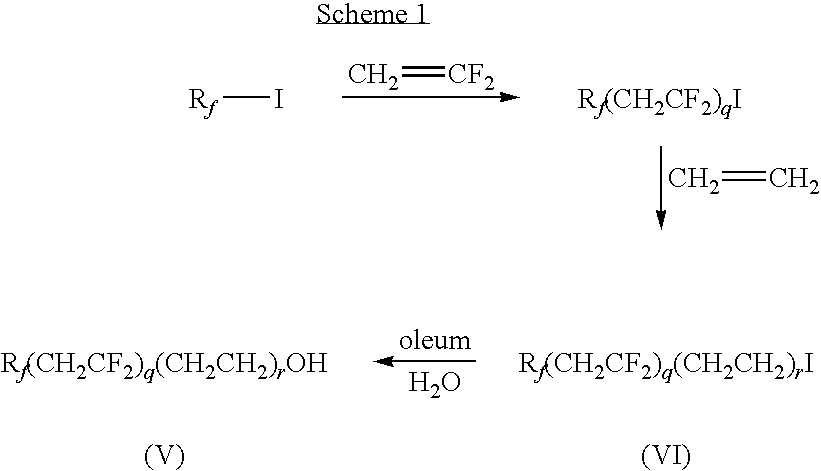Alkoxylation of fluorinated alcohols
a technology of fluorinated alcohol and alkylalkoxylate, which is applied in the preparation of organic compounds/hydrides/coordination complexes, physical/chemical process catalysts, and catalysts containing strong bases, etc., can solve the problems of insufficient alkoxylation of fluorinated alcohols, high cost of fluorinated materials derived from long-chain perfluoroalkyl groups having 8 or more carbons, and insufficient alkoxylation of alcohols with short-
- Summary
- Abstract
- Description
- Claims
- Application Information
AI Technical Summary
Problems solved by technology
Method used
Image
Examples
example 1
[0084]A clean dry round bottom flask (RBF) was charged with 40 grams of distilled C4F9(CH2CF2)nCH2CH2OH (121.9 mmols), wherein predominantly n=1; 0.175 grams (1.16 mmols) of sodium iodide, 0.20 grams (5.29 mmols) of sodium borohydride and 0.43 grams (1.17 mmols) of tetra-n-butylammonium iodide. The reactor was heated under N2 purge (no EO feed) to about 125° C. and held for 1 hour to complete the evolution of hydrogen during catalyst formation. After the evolution of hydrogen had ceased, as indicated by the absence of bubbling in the exit bubbler with the nitrogen purge turned off, the EO feed was started. Ethylene oxide was introduced in small 1-4 gram increments while maintaining at about 125° C.±15° C. Addition of ethylene oxide was continued over 6 days in shifts of about 3-8 hours, allowing the reaction mixture to cool and stand under nitrogen during overnight period The reaction was run at atmospheric pressure. The addition of ethylene oxide to the reactor was estimated by dif...
example 2
[0088]A clean dry (round bottom flask) RBF was charged with 40 grams of distilled C4F9(CH2CF2)nCH2CH2OH (121.9 mmols), predominantly n=1; 0.20 gms (1.33 mmols) of sodium iodide), 0.20 grams (5.29 mmols) of sodium borohydride and 0.47 grams (1.16 mmols) of methyl triphenylphosphonium iodide. The reactor was heated under nitrogen purge (no EO feed) to about 80° C. and held for about 1 hour to complete the evolution of hydrogen during catalyst formation. After the evolution of hydrogen had ceased, as indicated by the absence of bubbling in the exit bubbler with the nitrogen purge turned off, the EO feed was started. Ethylene oxide was introduced in small 1-4 gram increments while attempting to maintain 125° C.±15° C. Addition of ethylene oxide was continued over 6 days in shifts of about 3-8 hours, allowing the reaction mixture to cool and stand under nitrogen during overnight periods. Because the reaction was run at atmospheric pressure the addition of ethylene oxide to the reactor wa...
PUM
| Property | Measurement | Unit |
|---|---|---|
| pressure | aaaaa | aaaaa |
| pressure | aaaaa | aaaaa |
| temperature | aaaaa | aaaaa |
Abstract
Description
Claims
Application Information
 Login to View More
Login to View More - R&D
- Intellectual Property
- Life Sciences
- Materials
- Tech Scout
- Unparalleled Data Quality
- Higher Quality Content
- 60% Fewer Hallucinations
Browse by: Latest US Patents, China's latest patents, Technical Efficacy Thesaurus, Application Domain, Technology Topic, Popular Technical Reports.
© 2025 PatSnap. All rights reserved.Legal|Privacy policy|Modern Slavery Act Transparency Statement|Sitemap|About US| Contact US: help@patsnap.com



